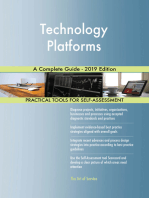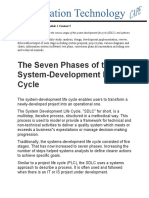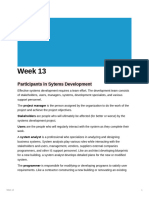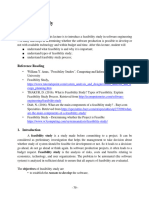OOAD Assignment 1
OOAD Assignment 1
Uploaded by
Mohsin MustufaCopyright:
Available Formats
OOAD Assignment 1
OOAD Assignment 1
Uploaded by
Mohsin MustufaCopyright
Available Formats
Share this document
Did you find this document useful?
Is this content inappropriate?
Copyright:
Available Formats
OOAD Assignment 1
OOAD Assignment 1
Uploaded by
Mohsin MustufaCopyright:
Available Formats
Chapter 1
EOC Questions
CHAPTER 1 Introduction to Systems Analysis and Design. 1. Compare and contrast phases, steps, techniques and deliverables. The Systems Development Life Cycle SDLC has a set of four fundamental phases: planning, analysis, design, and implementation. Different projects may emphasize different parts of the SDLC or approach the SDLC phases in different ways, but all projects have elements of these four phases. Each phase is itself composed of a series of steps, which rely upon techniques that produce deliverables (specific documents and files that provide understanding about the project). Example: When you apply for admission to a university, there are several phases that all students go through: information gathering, applying, and accepting. Each of these phases has stepsinformation gathering includes steps like searching for schools, requesting information, and reading brochures. Students then use techniques (e.g., Internet searching) that can be applied to steps (e.g., requesting information) to create deliverables (e.g., evaluations of different aspects of universities). 2. Describe the major phases in the systems development life cycle (SDLC). There are four major phases in SDLC. a) Planning: The Planning phase is the fundamental process of understanding why an information system should be built and determining how the project team will go about building it. b) Analysis: The Analysis phase answers the questions of who will use the system, what the system will do, and where and when it will be used. During this phase, the project team investigates any current system(s), identifies improvement opportunities, and develops a concept for the new system. c) Design: The design phase decides how the system will operate, in terms of the hardware, software, and network infrastructure; the user interface, forms and reports; and the specific programs, databases, and files that will be needed. d) Implementation: The final phase in the SDLC is the implementation phase, during which the system is actually built (or purchased, in the case of a packaged software design). This is the phase that usually gets the most attention, because for most systems it is longest and most expensive single part of the development process.
Page 1
Chapter 1
EOC Questions
3. Describe the principal steps in the planning phase. What are the major deliverables The planning phase is the fundamental process of understanding why an information system should be built and determining how the project team will go about building it. It has two steps: 1. Project Initiation: This step involves the identification of the systems business value. A system request presents a brief summary of a business need, and it explains how a system that supports the need will create business value. The IS department works together with the person or department that generated the request (called the project sponsor) to conduct a feasibility analysis. The feasibility analysis examines key aspects of the proposed project like the technical feasibility, economic feasibility and organizational feasibility 2. Project Management: Once the project is approved, it entersproject management. During project management, the project manager creates a work plan, staffs the project, and puts techniques in place to help the project team control and direct the project through the entire SDLC. The deliverable for project management is a project plan that describes how the project team will go about developing the system. 4. Describe the principal steps in the analysis phase. What are the major deliverables? The analysis phase answers the questions of who will use the system, what the system will do, and where and when it will be used. During this phase, the project team investigates any current system(s), identifies improvement opportunities, and develops a concept for the new system. This phase has three steps: 1. Analysis Strategy: Developed to guide the project teams efforts. Such a strategy usually includes an analysis of the current system (as-is system) and its problems, and then ways to design a new system (to-be system). 2. Requirements Gathering: The analysis of this informationin conjunction with input from project sponsor and many other peopleleads to the development of a concept for a new system. The system concept is then used as a basis to develop a set of business analysis models that describes how the business will operate if the new system were developed. 3. System Proposal: The analyses, system concept, and models are combined into a document called the system proposal, which is presented to the project sponsor and other key decision makers.
Page 2
Chapter 1
EOC Questions
The system proposal is the initial deliverable that describes what business requirements the new system should meet. This is really the first step in the design of the new system. 5. Describe the principal steps in the design phase. What are the major deliverables? The design phase decides how the system will operate, in terms of the hardware, software and network infrastructure; the user interface, forms and reports; and the specific programs, databases, and files that will be needed. The design phase has four steps: 1. Developing design strategy: This clarifies whether the system will be developed by the companys own programmers, whether it will be outsourced to another firm (usually a consulting firm), or whether the company will buy an existing software package. 2. Basic architecture design: This describes the hardware, software, and network infrastructure that will be used. In most cases, the system will add or change the infrastructure that already exists in the organization. 3. Database and file specifications: These define exactly what data will be stored and where they will be stored. 4. Program Design: The analyst team develops the program design, which defines the programs that need to be written and exactly what each program will do. This collection of deliverables (architecture design, interface design, database and file specifications, and program design) is the system specification that is handed to the programming team for implementation. At the end of the design phase, the feasibility analysis and project plan are reexamined and revised, and another decision is made by the project sponsor and approval committee about whether to terminate the project or continue. 6. Describe the principal steps in the implementation phase. What are the major deliverables? The final phase in the SDLC is the implementation phase, during which the system is actually built (or purchased, in the case of a packaged software design). This phase has three steps:
Page 3
Chapter 1
EOC Questions
1. System construction: The system is built and tested to ensure it performs as designed. Since the cost of bugs can be immense, testing is one of the most critical steps in implementation. 2. Installation: This is the process by which the old system is turned off and the new one is turned on. It may include a direct cutover approach, a parallel conversion approach, or a phased conversion strategy. 3. Support plan: This plan usually includes a formal or informal postimplementation review, as well as a systematic way for identifying major and minor changes needed for the system. 7. What are the roles of a project sponsor and the approval committee? Project sponsor: Project Sponsor could be represented either by an individual or a department or a team. The project sponsor is from where the request is generated. They are basically involved through out the various phases of the SDLC. a. The IS department works hand in hand with the project sponsor to conduct a feasibility analysis, be it a technical, organizational or an economical feasibility. b. During the Analysis phase the project team investigates any current system, identifies improvement opportunities and develops a concept for the new system in conjunction with the input from the project sponsor. c. At the end of the design phase the feasibility analysis and the project plan are reexamined and revised and the decision whether the project is to continue or terminated is made by the project sponsor along with the approval committee. d. The key deliverables for each phase are typically very long and are presented to the project sponsor for approval as the project moves from phase to phase. e. The project sponsor approves the key deliverables for each phase only after which the project moves from phase to phase. f. The project sponsor along with the users provides valuable comments which are used to re-analyze, re-design and re-implement a second prototype which provides few more features.
Page 4
Chapter 1
EOC Questions
Approval Committee: Sometimes referred to as the steering committee is the final decision maker regarding the fate of the project after carefully reviewing the system request, feasibility analysis, system proposal etc. a) In planning phase after feasibility analysis the approval committee decides whether the project should be undertaken. b) After Analysis the system proposal is forwarded to the approval committee to decide whether the project should continue to move forward c) During the Design phase the feasibility analysis and project plan are reexamined and the approval committee will decide whether to terminate or continue with the project 8. What does gradual refinement mean in context of SDLC? Generally, the clarity of understanding and the depth of detail of the new system are gradually refined during the phases of the SDLC. Initially, the requirements are only vaguely understood. This understanding is improved during the Analysis phase. Further detail is developed during Design, and then is fully expressed during Implementation. 9. Compare and contrast process-centered methodologies with data-centered methodologies. Process-centered methodologies: Process-centered methodologies emphasize process models as the core of the system concept. Example: Process-centered methodologies would focus first on defining the processes (e.g., assemble sandwich ingredients). Data-centered methodologies: Data-centered methodologies emphasize data models as the core of the system concept. Example: Data centered methodologies would focus first on defining the contents of the storage areas (e.g., refrigerator) and how the contents were organized. 10. Compare and contrast structured-design based methodologies in general to RAD-based methodologies in general. Structured design methodologies are usually fairly formal, step-by-step approaches to systems development. The project moves through the phases in a systematic way. The emphasis in most of these methodologies is development of paper-based specifications for the new system prior to implementation. RAD methodologies, on the other hand, tend to emphasize quick creation of a limited-capability version of the
Page 5
Chapter 1
EOC Questions
system or a model of the system. These methodologies focus on refining this preliminary system or model rather than trying to fully describe it on paper prior to implementation. 11. Compare and contrast extreme programming and throwaway prototyping. Extreme programming (XP): Extreme Programming is founded on four core values which provide a foundation on which XP developers use to create any system. The four core values are Communication, Simplicity, Feedback and Courage. Throwaway Prototyping: Throwaway prototyping-based methodologies balance the benefits of well thought out analysis and design phases with the advantages of using prototypes to refine key issues before a system is built. Each of these issues is examined by analyzing, designing, and building a design prototype. 12. Describe the major elements and issues with waterfall development. Waterfall Development follows the phases of the life cycle in sequence (Planning, Analysis, Design, and Implementation). Each phase is thoroughly documented and approval is required before proceeding to the subsequent phase. It is difficult, though not impossible, to go backwards in the SDLC under Waterfall Development. Waterfall Development requires that the system requirements be precisely specified prior to implementation and also often "freezes" those requirements during development. The high degree of effort devoted to specifying user requirements is a strength of Waterfall Development but specifying those requirements on paper is laborious and may lead to errors and omissions. "Freezing" the requirements during development helps assure that the system is developed according to specifications, but in a dynamic business environment, the system that is ultimately developed may bear little resemblance to what is actually needed at the time the project is completed. Therefore, extensive maintenance may be needed after implementation to revise the system to meet current conditions. The two key advantages of the structured design waterfall approach are that: It identifies system requirements long before programming begins It minimizes changes to the requirements as the project proceeds.
The two key disadvantages are that: a. The design must be completely specified before programming begins. b. A long time elapses between the completion of the system proposal in the analysis phase and the delivery of the system.
Page 6
Chapter 1
EOC Questions
13. Describe the major elements and issues with parallel development The parallel development methodology attempts to address the problem of long delays between the analysis phase and the delivery of the system. Instead of doing design and implementation in sequence, it performs a general design for the whole system and then divides the project into a series of distinct subprojects that can be designed and implemented in parallel. Once all subprojects are complete, there is a final integration of the separate pieces, and the system is delivered The major issues in this approach are that it still suffers from problems caused by paper documents. It also adds a new problem such as sometimes the subprojects are not completely independent; design decisions made in one subproject may affect another, and the end of the project may require significant integration efforts. 14. Describe the major elements and issues with phased development. Phased Development is a RAD methodology that does not attempt to develop the complete system initially. Instead, the system is generally specified. User requirements are organized into a series of versions. The first version includes the essential system components and is delivered to the users quickly. Subsequent versions add features and refinements to the system based on the initial specification plus the users' feedback and reaction to using the system. The critical issue with Phased Development is to accurately specify the initial requirements so that the first version provided to the users is useful, although incomplete. If this is done well, Phased Development will provide value to the organization by getting the users a system to use quickly. New requirements may be identified through user feedback as well, which improves the "fit" of the system to the business needs. 15. Describe the major elements and issues with prototyping. A prototyping-based methodology performs the analysis, design, and implementation phases concurrently, and all three phases are performed repeatedly in a cycle until the system is completed. Prototype is usually the first part of the system that the user will use and the key advantage of a prototyping-based methodology is that it very quickly provides a system for the users to interact with, even if it is not ready for widespread organizational use at first. The major problem with prototyping is that its fast-paced system releases challenge attempts to conduct careful, methodical analysis. Often the prototype undergoes such significant changes that many initial design decisions become poor ones. This can
Page 7
Chapter 1
EOC Questions
cause problems in the development of complex systems because fundamental issues and problems are not recognized until well into the development process. Example: Imagine building a car and discovering late in the prototyping process that you have to take the whole engine out to change the oil (because no one thought about the need to change the oil until after it had been driven 10,000 miles). 16. Describe the major elements and issues with throwaway-prototyping. In throw-away prototyping, there is a more careful and rigorous analysis performed as compared to Prototyping (more similar to the traditional SDLC). However, in the Design phase, models of various elements of the system are developed to help explore design alternatives and refine system requirements. These prototypes help users clarify their needs, options, and priorities. Once user requirements are established through reaction to the design prototype, it is discarded; however, the requirements it embodied are incorporated into the new system. Throw-away prototyping is very useful in situations where users are uncertain about key elements of the system. Throw-away prototypes can help focus users on design issues and improve understanding of business needs. The approach helps create a system that suits the users needs even though those needs may have been poorly understood initially. 17. What are the key factors in selecting a methodology? There are several factors that influence the choice of a methodology: Clarity of the user requirements Familiarity with the base technology System complexity Need for system reliability Time pressures & Need to see progress on the time schedule.
18. What are the major roles on a project team? Business analyst: Emphasis on the business issues addressed by the system: value of new system; identification of problems and opportunities; revision of business processes and policies. Systems analyst: Emphasis on IS issues of the system: how IT can be used to support business processes; design of new business process and IS; and enforcement of IS standards.
Page 8
Chapter 1
EOC Questions
Infrastructure analyst: Technical issues associated with integrating new system components to existing technical infrastructure. Change management analyst emphasis on facilitating organizational adaptation to new system. Helping to identify and overcome resistance to change and assuring adequate training and documentation of new system. Project manager: Ensuring that progress is made on the project: time schedules and budgets are met; supervision of project team; and manage relations with project sponsor and users. 19. Compare and contrast the role of a systems analyst, business analyst, and infrastructure analyst. These three roles emphasize different perspectives on the system. The business analyst represents the sponsor/users interests, while the systems analyst knows how to apply IS to support business needs. Together, the systems analyst and the business analyst can design a system that conforms to the IS standards while adding value to the business. The infrastructure analyst has more technical knowledge and provides the team with technical constraints, or identifies infrastructure changes that the new system will require. System Analyst: A System Analysts role is to: Identifying how technology can improve business processes Designing the new business processes Designing the information system Ensuring that the system conforms to information systems standards
Business Analyst: A Business Analysts role is to: Analyzing the key business aspects of the system Identifying how the system will provide business value Designing the new business processes and policies
Infrastructure Analyst: The Infrastructure Analysts role is to: Ensuring the system conforms to infrastructure standards Identifying infrastructure changes needed to support the system
20. Which phase in the SDLC is most important and why? All systems development projects follow essentially the same fundamental process called the system development life cycle (SDLC). The planning phase in SDLC is the
Page 9
Chapter 1
EOC Questions
most important phase because during this phase the project team identifies the business value of the system, conducts a feasibility analysis, and plans the project. This phase is the fundamental process of understanding why an information system should be built and determining how the project team will go about building it.
Page 10
You might also like
- System Analysis and Design - An Object Oriented Approach With UML Chapter 1Document8 pagesSystem Analysis and Design - An Object Oriented Approach With UML Chapter 1Jared TanNo ratings yet
- Pathfinder For PRMO PJDocument409 pagesPathfinder For PRMO PJAjitesh67% (6)
- Test Stand APIReference PosterDocument1 pageTest Stand APIReference Postervenugopal mNo ratings yet
- Business Process Automation Tools A Complete Guide - 2020 EditionFrom EverandBusiness Process Automation Tools A Complete Guide - 2020 EditionNo ratings yet
- Software Security Vulnerability A Complete Guide - 2020 EditionFrom EverandSoftware Security Vulnerability A Complete Guide - 2020 EditionNo ratings yet
- Systems Analysis and Design With UML, 4th Edition Chapter 1 Question SolutionDocument14 pagesSystems Analysis and Design With UML, 4th Edition Chapter 1 Question SolutionStanleyYeung100% (3)
- SADChapter 1 Hand Out Solved ExercisesDocument10 pagesSADChapter 1 Hand Out Solved Exerciseswww.mierafeshetuNo ratings yet
- CIS 320 Questions PG.36 1. Compare and Contrast Phases, Steps, Techniques, and DeliverablesDocument16 pagesCIS 320 Questions PG.36 1. Compare and Contrast Phases, Steps, Techniques, and DeliverablesAbdul YaminNo ratings yet
- The Systems Development Life CycleDocument3 pagesThe Systems Development Life Cycletruongnura008No ratings yet
- Lecture 3-System Analysis and Design-2Document53 pagesLecture 3-System Analysis and Design-2Pachalo TemboNo ratings yet
- ch3 Sad-1Document15 pagesch3 Sad-1hachalu50No ratings yet
- AnswersDocument49 pagesAnswersLawry Enzo100% (3)
- Backend NotesDocument46 pagesBackend Noteschristian MUNEZERO NSHUTINo ratings yet
- System Analysis and Design: Dr. Aymen Zreikat Mu'tah University IT DepartmentDocument48 pagesSystem Analysis and Design: Dr. Aymen Zreikat Mu'tah University IT Department_84mhmNo ratings yet
- System Analysis and Design SDLCDocument6 pagesSystem Analysis and Design SDLCApek KoreaNo ratings yet
- Chapter 1 - Introduction To Systems Analysis & DesignDocument57 pagesChapter 1 - Introduction To Systems Analysis & DesignMolebogeng FrancinahNo ratings yet
- System Development & SDLCDocument9 pagesSystem Development & SDLCproshanto salmaNo ratings yet
- Chapter Three: System Development Life Cycle (SDLC)Document10 pagesChapter Three: System Development Life Cycle (SDLC)Gemechis Lema100% (1)
- Analysis and Design of Information SystemsDocument58 pagesAnalysis and Design of Information SystemsHussein Al-sheikhNo ratings yet
- Mis - Unit4Document14 pagesMis - Unit4k.mustaq9999No ratings yet
- Systems Overview SDLCDocument72 pagesSystems Overview SDLCIsha BhattaNo ratings yet
- SummaryDocument28 pagesSummaryoo1699081No ratings yet
- Systems Development Methodology NotesDocument19 pagesSystems Development Methodology NotesdiscipletimzNo ratings yet
- Waterfall System Development ProcessDocument23 pagesWaterfall System Development ProcessMarsNo ratings yet
- NI Handouts (Last Day)Document4 pagesNI Handouts (Last Day)frederick_imperial_1No ratings yet
- System Development Life CycleDocument8 pagesSystem Development Life CycleHackers100% (1)
- Cape Notes Unit1 Module 2 Content 5Document23 pagesCape Notes Unit1 Module 2 Content 5Shanice RussellNo ratings yet
- Lecture 3Document5 pagesLecture 3Said Sabri KibwanaNo ratings yet
- SDL C PhasesDocument20 pagesSDL C Phasesomprakash sahNo ratings yet
- Software Process ModelDocument14 pagesSoftware Process Modeladitya keshariNo ratings yet
- SAAD DAY 2024 Package 1Document31 pagesSAAD DAY 2024 Package 1kashabrams2No ratings yet
- SDLC Day1Document17 pagesSDLC Day1Aye Khaing Khaing MoeNo ratings yet
- Mis Assignment (S)Document8 pagesMis Assignment (S)adityasharma8970No ratings yet
- Project Estimation and Plan: Steps in Feasibility AnalysisDocument11 pagesProject Estimation and Plan: Steps in Feasibility AnalysisKarmesh VarshneyNo ratings yet
- AIS Group 8 Report Chapter 18 Hand-OutDocument10 pagesAIS Group 8 Report Chapter 18 Hand-OutPoy GuintoNo ratings yet
- System and Technical DocumentationDocument8 pagesSystem and Technical DocumentationAffo AlexNo ratings yet
- System Development Life Cycle-FinalDocument11 pagesSystem Development Life Cycle-Finalsledge103No ratings yet
- Week 13Document10 pagesWeek 13Toğrul QuluzadəNo ratings yet
- Sir Adj.Document3 pagesSir Adj.Marivic JulianNo ratings yet
- Information System DevelopmentDocument31 pagesInformation System DevelopmentAbidah ZulkifliNo ratings yet
- Tutorial 1 - OOBDocument5 pagesTutorial 1 - OOBNur Afiqah P.No ratings yet
- System Analysis and DesignDocument6 pagesSystem Analysis and DesignHoney Gambhir100% (1)
- Planning and AnalysisDocument11 pagesPlanning and Analysismarkcerdon7No ratings yet
- SDLC Eddited - 2017Document9 pagesSDLC Eddited - 2017ano mlamboNo ratings yet
- System Development Life CycleDocument3 pagesSystem Development Life CycleinsprimovNo ratings yet
- Application DevelopmentDocument2 pagesApplication DevelopmentYamunaNo ratings yet
- System Development Life Cycle: Learning ObjectivesDocument34 pagesSystem Development Life Cycle: Learning ObjectivesNguyễn Thị Minh HàNo ratings yet
- Blantyre International University Systems Analysis & Design Assignment 1Document8 pagesBlantyre International University Systems Analysis & Design Assignment 1aizkorri__1528No ratings yet
- Question On Digital ThinkingDocument2 pagesQuestion On Digital Thinkingnovaluna1913No ratings yet
- Unit 2 SEDocument20 pagesUnit 2 SEyashthakare9267No ratings yet
- Unit 4 SDLCDocument5 pagesUnit 4 SDLChsisjsboNo ratings yet
- System Analysis - Zahid RaufDocument7 pagesSystem Analysis - Zahid RaufZain BilwaniNo ratings yet
- 5 SDLC Systems Development Life CycleDocument105 pages5 SDLC Systems Development Life CycleRae Anne Abrasado100% (2)
- Lecture 4 Feasibility StudyDocument53 pagesLecture 4 Feasibility StudyNan Thuzar LinNo ratings yet
- Master of Computer Application (M.C.A.) Semester-III & IVDocument17 pagesMaster of Computer Application (M.C.A.) Semester-III & IVतुमचाच कृष्णाNo ratings yet
- Module - 7 Information Systems Development PDFDocument15 pagesModule - 7 Information Systems Development PDFJan JanNo ratings yet
- Unit III. (MIS)Document20 pagesUnit III. (MIS)amitkumarpal2571No ratings yet
- System Development LifeDocument2 pagesSystem Development Lifesamcj4realNo ratings yet
- SDLCDocument21 pagesSDLClamichhanebibek8No ratings yet
- AIS Ch-5Document10 pagesAIS Ch-5Rabbumaa KabbadaaNo ratings yet
- How To Prepare A Digital Edition PDF Book With Scribus: What Do I Need?Document10 pagesHow To Prepare A Digital Edition PDF Book With Scribus: What Do I Need?miguelmrmNo ratings yet
- GPM32F011XBV10 eCCU6 PWM User (English Version)Document7 pagesGPM32F011XBV10 eCCU6 PWM User (English Version)ISHAK CHERGUINo ratings yet
- Grade 10 Cat Study Guide Gde - MGSLG 2023Document263 pagesGrade 10 Cat Study Guide Gde - MGSLG 2023jr7master123100% (1)
- Machine Learning Techniques QuantumDocument159 pagesMachine Learning Techniques QuantumVarshika GangwarNo ratings yet
- An Enterprise Architecture Design Build Approach - Innovate VancouverDocument37 pagesAn Enterprise Architecture Design Build Approach - Innovate VancouverInnovate Vancouver100% (3)
- ARXivar Next - Minimum Requirements 2.3.30 - INGDocument13 pagesARXivar Next - Minimum Requirements 2.3.30 - INGbluish.smokeNo ratings yet
- Extending ECC Framework 122 v2 Rev01Document118 pagesExtending ECC Framework 122 v2 Rev01Dock N DenNo ratings yet
- Course Time Table PDF 39877Document3 pagesCourse Time Table PDF 39877Megha ChauhanNo ratings yet
- UoS Template For PGRDMPDocument10 pagesUoS Template For PGRDMPNigus AberaNo ratings yet
- Perancangan Sistem Inventori Barang Pada Rehat Kopi 32 Berbasis WebDocument7 pagesPerancangan Sistem Inventori Barang Pada Rehat Kopi 32 Berbasis WebKhansa TsabitahNo ratings yet
- Secret - Piano Battle 1 PDFDocument2 pagesSecret - Piano Battle 1 PDFFider Chong Jo EyNo ratings yet
- 11th Class Com Guess Papers 2024 ShortDocument3 pages11th Class Com Guess Papers 2024 Shortzahidali70039No ratings yet
- SmalltalkDocument12 pagesSmalltalkNawij ItrahgNo ratings yet
- A Requirements-Based Approach For TheDocument4 pagesA Requirements-Based Approach For TheMesfin GudetaNo ratings yet
- Ansible Rhel 90Document72 pagesAnsible Rhel 90Zoumana DiomandeNo ratings yet
- 11 Computer Ethics Security enDocument62 pages11 Computer Ethics Security enr.ghosh2029No ratings yet
- Computer Architecture Experiment Lab 1: Warmup: Xiaohong JiangDocument8 pagesComputer Architecture Experiment Lab 1: Warmup: Xiaohong JiangdoomachaleyNo ratings yet
- BigKick Manual v1.5bDocument36 pagesBigKick Manual v1.5bryan.goanNo ratings yet
- 2015 - 2000005700 - v5 - MA SIGMA Lite - Quick User GuideDocument32 pages2015 - 2000005700 - v5 - MA SIGMA Lite - Quick User GuidebrandonNo ratings yet
- Poached Eggs, A Drop by Party RoundDocument6 pagesPoached Eggs, A Drop by Party RoundSus ManNo ratings yet
- NiitDocument3 pagesNiitAniket PuriNo ratings yet
- Functional Testing With ExamplesDocument10 pagesFunctional Testing With ExamplesSimonaNo ratings yet
- DS LAB-3 Rahul Singh (191B317)Document7 pagesDS LAB-3 Rahul Singh (191B317)Rahul Singh100% (1)
- Network Security v1.0 Product OverviewDocument29 pagesNetwork Security v1.0 Product OverviewRafael Gil FerquesNo ratings yet
- Mod Menu Log - Com - Idle.egg - Factory.inc - TycoonDocument2 pagesMod Menu Log - Com - Idle.egg - Factory.inc - TycoonPIEto kihhNo ratings yet
- Object Oriented Analysis and Design LaboratoryDocument130 pagesObject Oriented Analysis and Design LaboratoryRoshan Suresh100% (1)
- Thapar Institute of Engineering & Technology, Patiala: End Semester Examination (May 2019)Document4 pagesThapar Institute of Engineering & Technology, Patiala: End Semester Examination (May 2019)Forza HorizonNo ratings yet
- Gapiauth2 DartDocument8 pagesGapiauth2 Dartİlter Engin KIZILGÜNNo ratings yet

























































































